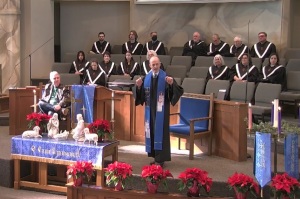A New Church for the New America: The Big Stretch of the Multiethnic Church (Pt. 2)
To be effective in the new America, churches must move away from their "nationalisms" (which we discussed in Part 1 of this series) and extend out beyond their preferred range of reach.
In doing so, as noted in the previous column, the "new church" will actually be the "old church" – the New Testament Kingdom of God variety that sometimes stunned, scandalized, and shocked society. It called runaway slaves "brothers" (Philemon), looked beyond ethnicity and gender (Galatians 3:28), and associated with social outcasts and the morally unfit (Matthew 11:19) – just a few among other violations of social, cultural, and religious convention.
The new America will be anything but conventional. What does it look like?
As a 28-year Houstonian, I greet the new America every morning. A Rice University study found Houston is America's most cosmopolitan city, surpassing New York and Los Angeles. Fort Bend County, home for many people in the church I now serve, has been declared America's most ethnically diverse. "Fort Bend County is the new America," said Mustafa Tameez, a political consultant cited in a New York Times report.
There are seven key principles for the multiethnic church I have learned in leading churches here and elsewhere. Here are the first three (the next four will be the subject of Part 3 of this series):
1. The multiethnic attitude and style must not be contrived.
Tom Wolfe may not be a church development consultant, but he provides vital understanding for congregations making the multiethnic stretch.
Wolfe's 1970 book, Radical Chic and Mau-Mauing the Flak Catchers, seared the contrived way some New York elites sought to stretch their arms for militant Black Panthers, a late-1960s revolutionary group. Wolfe focused on a 1966 party in the Park Avenue apartment of Leonard Bernstein, the composer and conductor. The event brought together celebrities like Hollywood mogul Mike Nichols, TV talker Barbara Walters, and others of their elitist caste. "Radical chic" became the symbol of efforts to make certain causes fashionable.
Falling into the radical chic trap is a danger for churches exploring new environments. Evangelicalism tends to chase movements. The churches I have served and observed in Houston that are successful in multiethnic outreach and ministry don't see multi-ethnicity as the newest "church growth" scheme. They don't "try" to be multiethnic. They do note the total demographic they seek to serve, but focus on people, their needs, and spiritual gifts for leadership and service within their congregations.
The truly multiethnic congregation must be neither radical chic, chasing a trend, nor robotic, as in simply going through the motions. Churches must look beyond mere cultural situations and phenomena, and simply embrace their identity as the Kingdom community within their localities. That will make the multiethnic stretch as normal, natural, and authentic as a big stretch when we rise from a good night's sleep.
The principle: When living and serving as the Kingdom community is a church's focus, multi-ethnicity "happens".
2. The multiethnic church must not be merely a patronizing institution, but cultivate the cross-ethnic, cross-cultural lifestyle.
As a newspaper reporter I encountered radical chic while covering a late 1960s meeting of the leadership of one of America's "whitest" denominations, about the time when Bernstein and the other Park Avenue "radicals" were wrapping their tailored attires in revolutionary flags without risking bloodying themselves in the trenches.
One of the events at the denominational leadership confab was "soul food night" when the leaders were driven to a black neighborhood to eat African-American cuisine in a backyard. I was struck with the incongruity of mavens of a church body enshrining a particular layer of America's socio-political strata seeking to identify themselves with people whose lives were a galaxy away from their own.
Though I appreciated the desire of the erudite officials to reach out, I winced over their inability to see how patronizing they appeared. The soul-food adventure seemed more a photo-op, designed to show the "relevancy" of the church's positions. Subsequent history demonstrated no change in the relational lifestyles or ethnic makeup of the denomination's local churches.
The principle: Multiethnic ministry is not patronizing events but a relational lifestyle.
3. The multiethnic church must also be multicultural.
As I noted in Part 1, cultural styles derive heavily from ethnicity. While I have understood this principle more broadly in Houston, I grasped it for the first time as senior pastor of a church in Birmingham, Alabama in the 1970s and '80s.
Our congregation didn't have time to "stretch" into a multiethnic attitude and practice –we were "jerked" in when 125 Cambodian refugees were moved into a community five miles from our church. We created a twice weekly institute where we taught English, basics of living in America, and the Bible. We even had Cambodian translation in worship services. Yet we were not effective initially in reaching them for Christ.
The breakthrough came when we sought to understand and communicate in the context of their culture. We learned that Cambodian New Year was as important to them as Christmas or Easter for Christians. But we debated how far to go in helping them celebrate using church facilities because of our concern for occult elements that might be embedded in the event.
The solution was to embrace the Cambodians and recognize the importance of their celebration, while using it as a teaching opportunity to point them to Christ. Contextualization has long been a strategic factor in international missions, but the church in the new America must learn and apply its philosophies and styles.
The principle learned: Prioritize people over their cultural expressions that might cause us discomfort, and affirm the witness of Christ within their context.
To embrace these principles and put them in practice will require many churches to stretch, but they must not become "elastic" in the process. We will examine this problem in Part 3, plus four more principles for developing the multiethnic church.




























